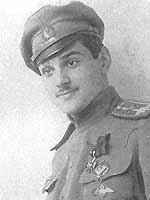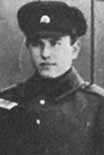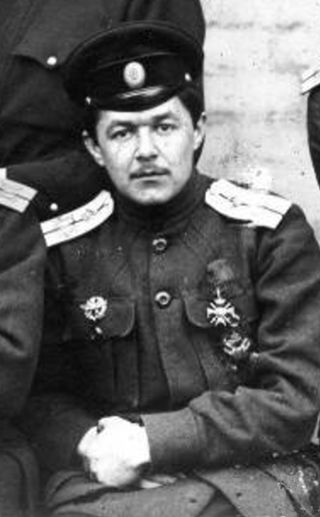
Pyotr Nikolayevich Nesterov was a Russian pilot, an aircraft designer and an aerobatics pioneer.

Nikolay Kirillovich Kokorin, was one of the most successful Russian flying aces and fighter pilots during World War I, credited with five aerial victories.

Cavalry Second Lieutenant Yury Vladimirovich Gilsher was a Russian fighter ace of World War I. Initially a cavalryman, but then an airman, Gilsher overcame two serious injuries to become an ace. After suffering a fracture of both bones in his right forearm, he later lost a foot to amputation because of a crash. He returned to duty with a prosthetic foot. Gilsher rose to his unit's command and scored five victories between April and July 1917 before being killed in action on 20 July 1917.

Ensign Ernst Krislanovich Leman (1894–1917) was a Russian World War I flying ace credited with five aerial victories.

Podporuchik Ivan Aleksandrovich Orlov was a Russian flying ace during World War I. He was a prewar flier, having built both gliders and an airplane, and having earned pilot's license no. 229 just prior to start of the war. He volunteered his experience and his personal airplane to his country's military service. His experience and his valor made him both a mentor and leader of less experienced pilots, as Orlov rose to command the 7th Aviatsionniy Ostryad Istrebitelei of the Imperial Russian Air Service. After an exchange duty assignment to the Escadrille 3, Aéronautique Militaire, he wrote the first Russian text on aerial combat, Ways to Conduct an Air Combat. He was killed in action after scoring five confirmed aerial victories.
Praporshik Aleksandr Mikhailovich Pishvanov was a World War I flying ace credited with five aerial victories. After an unsuccessful fight against the Communist takeover of Russia, he became an American citizen in 1928. His engineering skills were useful to both Sikorsky Aviation and to Seversky Aircraft Corporation from 1926 onwards. In 1942, he helped Walt Disney produce Victory Through Air Power to support the American war effort. Pishvanov's interest in aviation ended only with his death in New York City in 1964.

Lieutenant Eduard Martynovich Pulpe was a World War I flying ace credited with five aerial victories. He was a schoolteacher engaged in post-graduate study in France when World War I broke out. As he already held a civil pilot's license, he volunteered to serve in French military aviation. His 1915 aerial victories were among the first ever recorded. After running his score to four, he managed to return home to Russia in May 1916. He was assigned to the 10th Aviatsionniy Otryad Istrebitlei. After becoming an ace on 1 July 1916, he was killed in action a month later. On 2 August 1916, Eduard Pulpe ultimately lost a nearly hour-long air battle against three enemy aircraft.

Lieutenant Mikhail Ivanovich Safonov was a World War I flying ace credited with five aerial victories. He began his naval service on 20 September 1909, when he entered Saint Peterburg's Imperial Russian Naval Academy. When he applied for aviation training in September 1915, he was a professional sailor with six years naval training and seagoing service.

PolkovnikIvan Alexandrovich Loiko was a World War I flying ace credited with six confirmed aerial victories by the scanty and confusing records still existent. He rose to command a fighter unit, the 9th Fighter Aviation Detachment. After serving his czar faithfully until the October Revolution, in December 1918 Loiko joined the White Russian movement to reinstate his sovereign. When they were defeated by the Bolsheviks, Loiko turned to service in the Kingdom of Yugoslavia's air force in 1921. Two years later, he defected back to Russia in a Yugoslavian Breguet 19. From 1924-1929, Loiko served in the Red Army Air Force. In 1929, he was convicted of espionage on behalf of Romania and sentenced to ten years imprisonment. He served five years on Vaygach Island, and remained there after his release from captivity. He is believed to have committed suicide in April 1936.
Captain Konstantin Konstantinovich Vakulovsky was a World War I flying ace credited with six aerial victories. A major general's son, he volunteered for aviation duty on 8 August 1914, six days after graduating from university. He taught himself to fly, and became one of Russia's first military pilots on 13 June 1915. After escaping the fall of the Novogeorgievsk Fortress in a hazardous flight, Vakylovsky flew reconnaissance missions, some through heavy ground fire. Given command of the newly formed First Fighter Detachment, he became a flying ace credited with six aerial victories. He died in a flying accident during summer 1918.

PodpolkovnikYevgraf Nikolaevich Kruten was a World War I flying ace credited with seven aerial victories. He began World War I as an aerial observer with three years experience in military aviation. After a year's seasoning, he was recommended for, and graduated from, pilot's training in September 1914. He rose through the ranks, to be appointed as his unit's commander on 6 June 1916. With his victory tally at three, he was forwarded to service with the French Aéronautique Militaire. While learning French aerial tactics, Kruten shot down a German aircraft during February 1917. After his return to Russia in March 1917, he shared his new-found knowledge in a flurry of booklets on military aviation. He commanded his battle group of three detachments, and ran his victory total to seven before dying in a landing accident on 19 June 1917.
Captain Vladimir Ivanovich Strzhizhevsky was a World War I flying ace. He volunteered for military service on 14 October 1914, after graduation from Petrograd Technical Institute. Incomplete and confusing records credit him with eight confirmed and four unconfirmed aerial victories during his 1916-1917 combat on the Romanian Front. His second wound ended his tally of aerial victories. The advent of the October Revolution saw him co-opted into the Red Air Force for the end of the war. On 4 November 1918, he defected to the White Russian Army, and served with them for two years. When they were expelled from Russia, Strzhizhevsky accompanied them. He became a Yugoslav citizen and joined their air force.

PoruchikDonat Aduiovich Makijonek was a World War I flying ace credited with eight aerial victories. He was the only ace of Polish ethnic heritage to fight against the Central Powers. In later life, he would help found Polish military aviation immediately after World War I, and fight in the Polish-Soviet War of 1919-1921.

KapitanVasili Ivanovich Yanchenko was a World War I flying ace credited with 16 aerial victories. He graduated his secondary education as a mechanical engineer in 1913, with an interest in aviation. He learned to fly shortly after graduation.

PraporshikGrigoriy Suk was a flying ace for the Imperial Russian Air Service during World War I.











